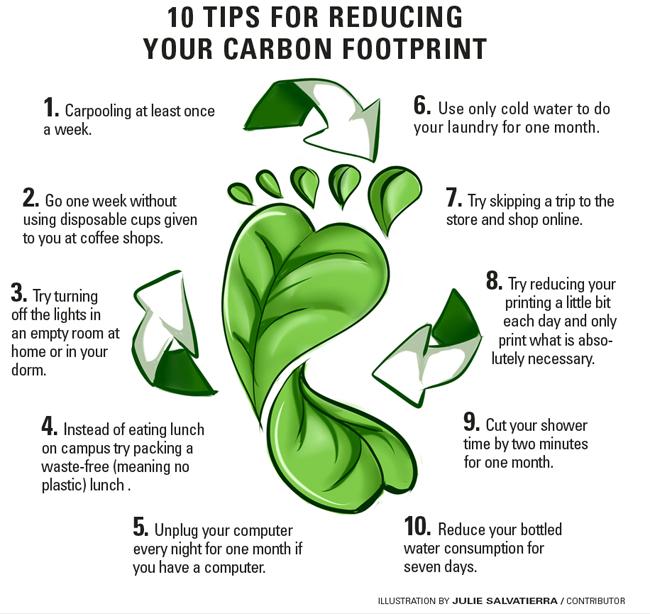Whether at home or school, or while traveling, the way people dispose of the items they buy and the food they eat affects theirs carbon footprint.
A carbon footprint is a measurement of the carbon dioxide (CO2) people produce, according to an article by howstuffworks.com
Much of the things people do as part of their daily lives relies on the usage of fossil fuels like gas, oil and coal. The burning of fossil fuels produces greenhouse gases, such as carbon dioxide, which is a major contributor to global warming, according to the article.
“The amount of one’s own carbon dioxide emission has a personal impact on climate change,” said CSUN professor Helen Cox, who is a geography professor and works institute for sustainability. “An increase in carbon dioxide causes warming and it mixes in the atmosphere and it gets shared all over the world.”
Some impacts from global climate change includes more extreme weather events like droughts, floods and less snowfall, which affects our water supplies, Cox said.
Sarah Guajardo, 20, junior and English major, has been trying to reduce her carbon footprint by changing her lifestyle.
“I ride my bike anywhere I can or just walk. I think it is important to try and reduce your carbon footprint and educate other on how to do it,” Guajardo said. “I’ve talked to my friends and family and they have all been really supportive and I see them try and do their part by not using plastic and recycling stuff.”
Another student on campus making a difference is Emmanuel Martin, 19, freshman undecided major.
“I’ve stopped using plastic straws completely,” Martin said. “They are useless and such a waste of plastic. Plastic lives pretty much forever and the materials used to make plastic is bad on the environment too. If I can do something so little that doesn’t make my life more difficult and helps out the world, I’ll try anything.”
Helping to reduce your carbon footprint has become carbonrally.com’s philosophy. Carbonrally is a website that offers groups or individuals challenges to spread awareness of climate change, which are posted every few weeks. These challenges are made to be simple, fun and a social way to have an effect and bring awareness to people’s energy use and climate change, according to carbonrally.
How it works. Participants choose a challenge they would like to complete online and create a My Carbon Page. Then people can check out the results on how they are doing or they can view the Total Impact Map for the site’s real-time shot of people’s results in different parts of the United States.
It tells the user the exact details on how to complete the challenge and the connection it has with the individuals results. You can also check how many people have attempted and/or completed the challenge nationwide. With each challenge completed, it tells the user the total savings of carbon dioxide pounds.
According to an article on nature.org having people contribute to these challenges or do their own versions of them will help ensure a stable climate for future generations.
Users can create teams among friends, family or whomever. Carbonrally also encourages users to post their own creative ideas on their Challenges Workshop area.
Some trending challenges on the website have to do with planting your own vegetable garden, giving up paper towels, or walking into a place of business instead of using the drive-thru whether it be a bank or restaurant.
“Stop buying bottled water,” Cox said. “That is one thing students at CSUN can do to help. People also need to use less energy overall by using public transportation, walking, using less heat, less air conditioning, less water and buying less items (consumables).”
“It is important people understand that this is our home and in order to live here we have to keep it safe and clean,” Guajardo said. “I just wish people would care more and really see the impact they can make by just doing small things to better our world.”
10 tips for reducing your carbon footprint
- Carpooling at least once a week.
- Go one week without using disposable cups given to you at coffee shops.
- Try turning off the lights in an empty room at home or in your dorm.
- Instead of eating lunch on campus and try packing a waste-free (meaning no plastic) lunch .
- Unplug your computer every night for one month if you have a computer.
- Use only cold water to do your laundry for one month.
- Try skipping a trip to the store and shop online.
- Try reducing your printing a little bit each day and only print what is absolutely necessary.
- Cut your shower time by two minutes for one month.
- Reduce your bottled water consumption for seven days.

